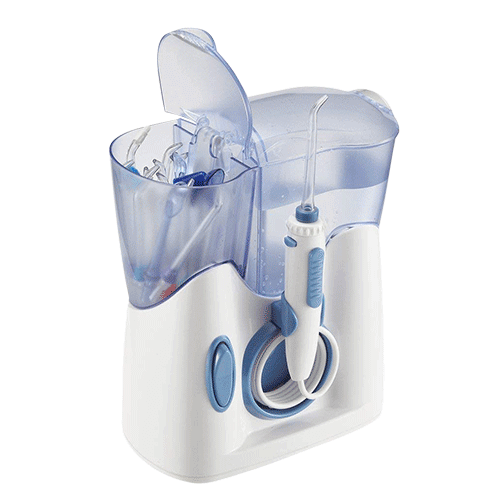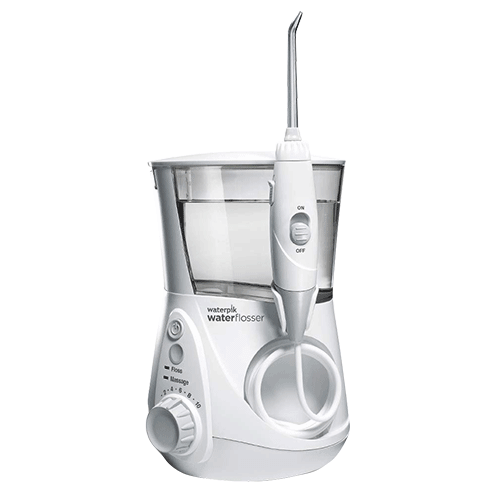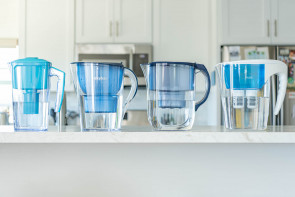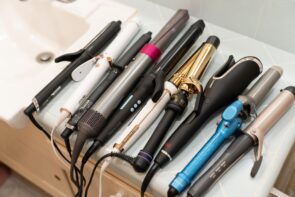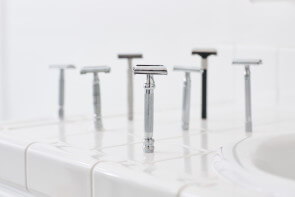
The Best Water Flossers
Through over 20 hours of use, consulting with a dentist with 22 years experience and water flossing after over 80 meals, we found the h2ofloss – hf-8 to be the best water flosser. It proved the most effective, and it can be used by multiple family members with differing gum sensitivity. The h2ofloss also has the biggest water reservoir as well as the widest variety of pressures to choose from. The Waterpik – WP-660 was a close runner-up.
Through over 20 hours of use, consulting with a dentist with 22 years experience and water flossing after over 80 meals, we found the h2ofloss – hf-8 to be the best water flosser. It proved the most effective, and it can be used by multiple family members with differing gum sensitivity. The h2ofloss also has the biggest water reservoir as well as the widest variety of pressures to choose from. The Waterpik – WP-660 was a close runner-up.
Table of Contents
- The 8 water flossers we tested
- Best overall: h2ofloss – hf-8
- Also great: Waterpik – Aquarius
- Best cordless: SmarToiletries – STO-PO2016
- Other products we tested
- How we selected
- How we tested
- Why would you need a water flosser?
- Important features to consider
- The bottom line
The 8 water flossers we tested

| Product | Price | Tips | Pressures | On/Off Switch | Water Tank (seconds on high) |
|---|---|---|---|---|---|
| 1. H2ofloss - hf-8 | $$ | 12 | 5 | Yes | 150 |
| 2. Waterpik - WP-660 | $$$$ | 7 | 10 | Yes | 120 |
| 3. SmarToiletries - STO-PO2016 | $$$ | 4 | 3 | Yes | 30 |
| 4. Nicefeel -FC168 | $$$ | 7 | 10 | No | 120 |
| 5. Belmint - BEL-WF | $$ | 3 | 10 | Yes | 135 |
| 6.Waterpik - WP-72 | $$$ | 3 | 6 | No | 150 |
| 7.ProFloss - 4190 | $ | 1 | 4 | No | Infinite |
| 8.Panasonic - EW-DJ10-A | $$ | 1 | 2 | Yes | 35 |
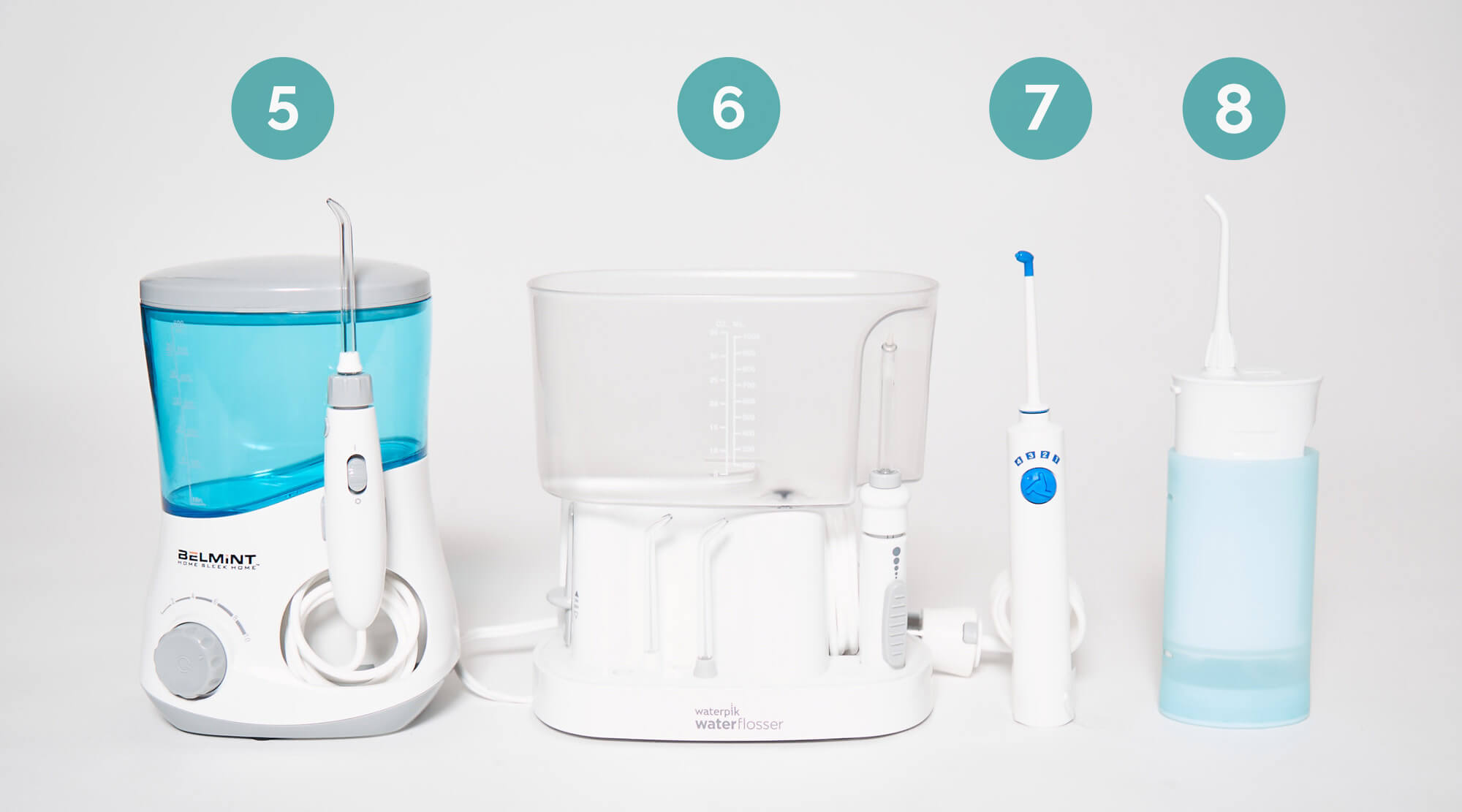
Best overall: h2ofloss – hf-8
The h2ofloss – hf-8 puts to rest nearly every excuse to avoid flossing (and it was our favorite flosser). Whether you have sensitive gums or very hard-to-reach crowns, this water flosser provides you with the pressure you need to keep your teeth clean and your gums healthy. We loved the way you can lower the pressure on the handle when approaching a sore spot in your mouth (wisdom teeth coming in), and then turn it right back up to remove that stuck piece of food elsewhere. We found this to be our go-to flosser because the pressure is very natural to control and was effective every single flossing.
Something that really sets the h2ofloss apart is its compartment and stand for the extra tips. Some of the other brands will give you several tips, but nowhere to store them! With a collapsible stand that holds seven tips, you will never be left looking for the right one. Happily, the tips are also color-coded, so it is easy to share the machine with family members.
Another specialty tip that is included is the periodontal tip, which is meant to be used for implants because of their increased required maintenance. We found that this tip can be used for everyday use as well and is especially good for permanent retainers or very small hard-to-reach spots.
With the second biggest water reservoir, the h2ofloss – hf-8 takes over two minutes to use up all the water when the water flosser is on its highest setting. The h2ofloss is also extremely quiet and waterproof.
Key takeaways:
- We love the controls on the handle of the h2ofloss – hf-8 water flosser. You can easily switch from off to five different pressures while the machine is on, giving you all the control you need in your hand.
- With an 800-ml reservoir, you get 150 seconds of use on its highest setting, which is more than enough time to do multiple cleans.
- With five different options to choose from, the h2ofloss has the widest range of pressures of any flosser we tested. This means that it works for both sensitive gums and that piece of cracker that is lodged in between your teeth.
Also great: Waterpik – Aquarius
We loved the automatic ‘pacing’ reminder system on the Waterpik – WP-660, as it allows you to zone out during your morning bathroom routine. The quality of flossing is high and it gives you control of the water flow from the handle.
With a more average-sized water tank than the h2ofloss, the WP-660 can be used for about two minutes on “high” before running out of water. The manufacturer claims 90 seconds, but they’re just being modest! In our pressure test, the WP-660 provided a wide range, which makes it a versatile flosser. It has four useful specialty tips: an orthodontic tip, periodontal tip, plaque tip, and toothbrush tip.
Although they give you all of these convenient tips, there is very limited space to store them. On the upside, something this water flosser has that the best pick is lacking is a 30-second and one-minute timer, which allows you to stay on track and not over-floss. There is also a hydro-pulse massage mode that is unique to the WP-660, which is perfect for sensitive gums or for those who are just getting started. Compared to the normal stream, it halves the amount of water used with its quarter-second pulses.
A quick note on the control: there is an on/off switch on the handle of the water flosser that gives you easy command (and keeps the water from spraying where you don’t want it). The pressure settings are on an easily visible knob on the base of the machine. All you have to do is select your preferred pressure and floss away!
Key takeaways:
- The Waterpik – WP-660 has a knob on the side of the machine that gives you 10 pressure settings to choose from. It is the only water flosser that has a separate massage setting that gives your gums intermittent breaks.
- Tip selection is second to none: in addition to three standard tips, there is an orthodontic tip, periodontal tip, plaque tip and toothbrush tip.
- Pressure control is completely intuitive and gives you ultimate control over how hard or soft you need it. There’s also an easy-to-use on/off switch on the handle of the water flosser.
Best cordless: SmarToiletries – STO-PO2016
[Update: although it’s still available in the dark blue color from SmarToiletries, it looks like the original white color is available from the company rebranding this item, ToiletTree Products.]
It was very easy to choose the winner of this category. The SmarToiletries – STO-PO2016 is the only cordless flosser that we’d really use. It requires minimal effort, looks clean, and is a nice in-between size that allows for simple travel, while still maintaining a big enough reservoir for a nice clean. It has comparable pressures to the corded flossers, which is more than enough to end your toothpick struggles.
We like that it uses a charging mechanism as opposed to batteries because, well, sometimes batteries are hard to come by in a messy drawer. The SmarToiletries has one of the best handles because it has an on/off switch and you can change the pressure setting.
If you have an average-sized dopp kit, the SmarToiletries will fit in nicely. So, you can take it on trips and keep your teeth and gums healthy and happy. Since the reservoir allows for 45 seconds of water flossing or 30 seconds on high pressure, you’ll have more than enough time to get that annoying mustard seed out of your permanent retainer. Also, refilling it is intuitive and only takes a couple of seconds.
Key takeaways:
- At just over seven inches in length, the SmarToiletries – STO-PO2016 is a perfect choice for an on-the-go water flosser because it gives you all power you need for a good clean and has easy-to-use settings on the handle.
- You’ll have 30 seconds of high pressure to get those seeds out of your teeth. You can even floss in the shower, thanks to a waterproof design.
- The SmarToiletries is beautifully designed and so simple to use that you will have no excuse to avoid flossing.
Other products we tested

Belmint – BEL-WF
The Belmint – BEL-WF is extremely solid. It’s also the best-looking flosser, which did make it that much easier to adapt to. At the end of the day, that’s what we really want, and if you are trying to get your kids to use it then this may be your best bet. It’s not quite as powerful as some of the top water flossers, but the difference is small. It still provides the usual pressure settings necessary to get most jobs done.
Some very innovative thinking took place in the design of this flosser: the lid doubles as a dust-proofer and storage for up to four tips, so it keeps the both the countertop clutter-free and the water inside clean. The Belmint is akin to the Waterpik – WP-660 (the runner-up) in many respects: it has an on/off switch on the handle and a knob you turn to choose the strength of the stream. It also has a couple minutes’ water tank capacity, and there is a timer with thirty-second warnings.
This flosser is great for those with sensitive gums because it offers the lowest pressure out of the flossers and uses the least amount of water on that pressure. The Belmint – BEL-WF can be used for over seven minutes on its lowest setting, which is the longest out of any product we tested (even though it has an average-sized tank). Another fun little feature that the Belmint has, which kids may like, is a magnetic holder for the handle.
Nicefeel – FC168
The Nicefeel – FC168 has the best extra-tip storage of any product we tested. And, yes, that means Nicefeel gives you multiple useful tips (not just a bunch of standard tips). It has an orthodontic tip, periodontal tip, and plaque tip that can either be stored inside the lid of the water reservoir or in a stand on the side of the water tank. This is a perfect product for a family, as it is a shareable product that includes three color-coded standard tips.
This water flosser is not for those with sensitive gums. Although there are 10 pressure choices (which is standard), the difference between low and high is minimal as all of the pressure is pretty high. Regardless, you can use it on ‘high’ for about two minutes, which is easily time enough to get the job done even if you have tough crowns or braces.
The reason this water flosser is harder to control than the rest is because it only has a pause button on the handle, as opposed to an off switch, making it susceptible to slipping and spraying everywhere. Contrary to what you may think, the automatic setting is ‘on’. So you have to manually push the button down when you want the water to stop shooting out, or press the master switch on the base. There is a lifetime warranty and a one-year money-back guarantee on this flosser.
Waterpik – WP-72
You could keep a couple of goldfish in this tank, it’s so big! Okay, we’re kidding, but the Waterpik – WP-72 is about one and a half times bigger than the others. Unfortunately, there is no lid to keep dust from getting in the water like every other water flosser we tested. (Though this may not be a problem in your bathroom.)
The tank does flip over and double as a cover to the flosser, which makes it very compact if you plan on taking it somewhere with you. If you aren’t worried about dust settling in the tank, then the generous amount of water might last you three or four days between filling.
It comes with two standard tips and a periodontal tip, which, as we’ve said, comes in handy for things like a permanent retainer. It can reach those really small and hard-to-reach spots in between your teeth. There are six different pressure settings, but no on/off mechanism on the handle. Sure it’s easy enough to press the switch on the base, but we prefer control on the handle.
ProFloss – 4190
The best way to describe the ProFloss – 4190 is that it’s unconventional. There is no reservoir and there are no pressure buttons. Instead, it is a direct attachment to your faucet. All you do is unscrew the aerator on the bottom of your faucet and screw in theirs. Its aerator has both internal and external threads, so it will fit onto most faucets.
It’s not too hard to put on (assuming your aerator is not stuck on there like ours was). It only takes about a minute and from there all you have to do is pop in the spiral-cord and you’re all set. The pressure is adjusted the same way you’d adjust the pressure of your faucet while washing your hands.
Because there’s no water tank, there is an endless supply of water, but you will have an enlarged aerator attached to your faucet. You don’t need access to power of any type, just a faucet with running water. It’s also incredibly small and easy to pop in your toiletry bag or keep in your bathroom drawer. Not too bad for less than 20 bucks.
Panasonic – EW-DJ10-A
Another “not-by-the-book” water flosser is the Panasonic – EW-DJ10-A. In order to save space, the top portion of this flosser slides down into the reservoir as the water level drops. At first glance this is a good design idea because it seems efficient.
However, even though the on/off switch is on the handle, it is not easy to switch off the flosser. As one part of the flosser slides over the switch, it becomes covered. So if you want to stop halfway through, it requires two hands: one to hold the flosser and one to uncover the switch. It can be hard to tell when the water is done, so take care when you take it out of your mouth so the thing doesn’t run wild.
It gets easier to control over time as you know what to expect and how to bend your face down towards the sink when you take it out, but that’s a lot to have to adapt to. Also, the shape is not very ergonomic.
Also, a little side note, if you are having trouble accessing the batteries on this flosser, try using a nickel.
How we selected
When we started researching water flossers, the first thing we did was speak with Dr. Roxanna Baghai, a dentist in Southern California who has been practicing for over 22 years. We asked about the debate between water flossing and standard flossing right away. Dr. Baghai emphasized the importance of standard flossing, advising that “Waterpiks don’t replace flossing. Flossing is always a must. They (the water flossers) should always be used as an adjunct to flossing.”
So, we pressed further to see if water flossers actually help to reduce plaque, bacteria, and the likelihood of gingivitis. She said, “Absolutely! Absolutely, they still work towards that because they still break up the food from setting in there between the teeth. The Waterpiks are also good for bridges, which is when two teeth are connected, and good for gaps.”
With this clearer understanding of the benefits of water flossing, we went through various websites and forums to find the features that consumers search for in a water flosser. We looked for reputable review sites (like Consumer Reports and Wirecutter) but came up empty-handed: none of the big-name publications have reviewed water flossers. So we took other measures, looking through the more detailed reviews of the products on Amazon’s bestseller list. We also went through the website of one of the most well-known manufacturers out there (Waterpik) to see what they had to say about flossers in general.
Once this was all done, we ordered a combination of the best water flossers. We tested both corded and cordless models for those of you who are on the go or don’t want to sacrifice any bathroom counter space. We pitted them against one another to find the best through a series of objective and subjective tests.
How we tested
We grouped the testing into four categories: cleaning performance, ease of use, water pressure and capacity, and flossing tips.
Cleaning performance
It’s always nice to see the stats, but what really matters with products like water flossers is that they work. Do they get the food out of your teeth? Are they kid-friendly? We kept notes on our experience with each water flosser after (almost) every use.
We used each flosser for about a week in order to get a feel for them and see what aspects might not be obvious from our controlled testing. We also started flossing daily so that we could understand the difference between water flossing and traditional flossing. The former is much easier to do (and a lot more fun, even though that novelty wears off).
Even the lower settings on the water flossers get most of the food out. But when there is some really tough stuff, the h2ofloss – hf-8 comes in handy because you can adjust the pressure in hand. There is less pain with water flossing compared to traditional flossing, and even though you have to fill the machine up every couple of days, this only takes about 10 seconds.
Ease of use
We found it easiest to control water flossers that had a simple on/off switch on the handle instead of pressure-setting controls. It is easier to choose your setting before you turn it on or off. This way, you also avoid inadvertently switching between pressures as you are using the flosser or trying to turn it off.
Some of the water flossers that have pressure settings on the handle also have an off setting, or a pause setting. However, that requires more movement of the switch than does a simple click from on to off. That said, our favorite overall water flosser had the pressure selector on the handle, so it’s not a deal-breaker.
One of the things we found that made the water flossing experience more enjoyable is when we had the most control over the product. That means the least amount of mess and the most amount of water going down the sink. (Note: some of the products take getting used to, like the Nicefeel, which is automatically turned on and requires the button to be pressed down to pause the squirting.) Additionally, we looked at how easy it was to refill the tank. We’re happy to say: all the flossers have very easy-to-remove reservoirs.
Water pressure and capacity

Water pressure is an integral part of cleaning performance because a higher pressure allows for a better clean. So, we put each flosser at a specific height and angle to see how far each shot water on all of its different settings.
Here’s where we really had some fun. Initially, we thought the water flossers wouldn’t shoot water more than a few feet. However, when we plugged in the first one, the water shot out with way more power than expected — at that point we knew there would need to be some outdoor evaluation.
We put each water flosser four feet above the ground and shot the stream parallel to the ground to see how far (in feet) each water flosser shot on both the low and high settings. Three water flossers tied in terms of power (or distance) on their highest settings. However, the h2ofloss – hf-8 displayed the widest range of pressures going from 11 feet to 24 feet, which means it is also great for sensitive gums.

We also checked the reservoir capacity of each flosser, as well as the amount of time it took to empty the reservoir. The average reservoir size is around 600 ml, which lasts for about two to three uses. We were surprised to find that some of the manufacturers understated how long the water would last by about 30 seconds per tank. However, the H2o matched its claim to the second.
Flossing tips

We rated each of the water flossers based on the number of included tips and if they did the job they claimed to do. We found that a decent number of the brands that claim multiple tips are just giving the consumer multiple of the standard tip. This is good if you are sharing the water flosser among family members, but not as good if you need tips specifically for braces or crowns.
Even though the generic tip is good for most circumstances, it is nice to have a selection. The periodontal and orthodontic tips proved especially useful as the former is great for permanent retainers and the latter when working with sensitive gums. To change a tip on any of the flossers, all you do is push in a button and switch out the current tip.

So, if you have all of these extra tips, where are you supposed to store them? We also judged the water flossers on the tip-storage they provide. The Nicefeel – FC168 particularly impressed us with their tip storage as there are two compartments: one is seamlessly integrated into the base of the flosser with a clear plastic that protects your tips from dust and the other is part of the lid.
Why would you need a water flosser?
If you’re like 60% of Americans, according to the American Dental Association, then flossing is not something you do every day. So, we put in the work to determine which water flossers can most easily be added to your morning routine. Even though our dentist consult told us water flossing should be used in addition to normal flossing, she also said that “using [only] water flossers is absolutely better than nothing.”
One of the main benefits of a water flosser is that it is quick and easy. All you need is water (and an outlet if your flosser is corded). Water flossers basically break up the formation of plaque and bacteria so they don’t lead to cavities and gingivitis. Keeping the bacteria and plaque at bay can also promote better breath, cleaner teeth and a great smile.
And for some of the biggest annoyances that traditional flossing can’t seem to circumvent, a water flosser is the perfect alternative (though Dr. Baghai insists that flossing is still important). These annoyances include braces, a permanent retainer, crowns, and bridges. In short, if you don’t floss, then water flossers are something you should consider because it is much easier and faster than traditional flossing and promotes overall dental hygiene and health.
Important features to consider
What to look for in a water flosser is largely dependent on your needs. For instance, if you have braces, then you are going to want a water flosser that has a special attachment or tip that is specific to braces. That being said, we found that you can do almost as good of a job with the standard tip. If you have sensitive gums, then you are going to want a water flosser with a variety of pressures that includes low pressure and possibly massage.
Cordless vs. corded: This is usually the first differentiator to consider. The cordless water flossers are meant to be used for travel because they are very small in comparison, are easily packable for your travels and have the water tank as the handle.
Corded water flossers, on the other hand, are usually going to give you a wider variety of tips, a bigger difference between pressure settings and much larger reservoirs. Corded flossers are better for everyday use. They will take up a bigger spot on your bathroom counter next to your sink, which also provides a great visual cue that reminds you to water floss!
Pressure: We all have different preferences and gum sensitivities. If you are going to be sharing the water flosser with your family, it is better to find one that has a wide range of pressures. If you have sensitive gums, then perhaps one with a softer setting and a massage setting, like the Waterpik – WP-660, would be good for you.
If you have tough gums and wide gaps between your gums and teeth, then you will require more pressure to get rid of food and break up plaque. This is also where the different types of tips come in handy. We found that having some sort of bristle on the end is very useful.
Different tips: All of the water flossers come with a standard tip, which is like an angled straw that narrows to a cone shape at the end. Some include special tips, like the “Plaque Seeker Tip” on the WP – 660, which is best for implants, crowns and bridges. It has the same sized hole as a standard tip and is equipped with three sections of quarter-inch long bristles to aid in the clearing of food.
On/Off switch on the handle: This makes for much easier use. There are different types of on/off switch. For instance, some have all of the different pressures on the handle, and others have only an on or off setting. One water flosser (the Nicefeel – FC168) has a button that must be manually held down to stop it from squirting, ‘on’ and ‘off’ are only on the base. Needless to say, we got wet the first time we used it. We prefer the simple on/off switch.
Water reservoir: The amount of water the reservoir holds is key. For example, the WP – 72 holds 1,000 ml, which is 167% of the normal 600 ml reservoir. We found this very convenient. Though filling up the reservoir in a compact model once or twice a day isn’t the end of the world, a larger reservoir is ideal if you can spare the counter space.
Footprint size: The sizes of most corded water flossers don’t differ too much. As a general rule, a bigger capacity means a larger footprint. That said, the average-capacity Belmint and Waterpik – WP-660 take up about three-quarters of the space that the others do. As expected, the 1,000 ml Waterpik – WP-72 takes up the most space.
Noise level: Nobody wants to buy a product that is incredibly loud, especially as water flossing may take place in the morning when your family members are sleeping. Our results, however, show the sound to be between 55 and 65 decibels from six feet away: a pretty quiet sacrifice for good dental hygiene.
The bottom line
The fight for the top was a tough one this time around. Both the h2ofloss – hf-8 and the Waterpik – WP-660 are phenomenal water flossers. Ultimately, though, the h2ofloss came out victorious with an ability to store all of its extra tips, a wider range of pressures and a cost around two-thirds of the price of the Waterpik.
The WP-660 was the best in category as far as extra tips go, with four different specialty tips that can cover all of your needs from cleaning crowns and implants to braces and permanent retainers. The best cordless was a no-brainer, as the SmarToiletries – STO-PO2016 puts the other two cordless flossers we tested to shame and even rivals the pressure of some of the corded flossers. In the end, though, the h2ofloss – hf-8 gave us everything we were looking for in a water flosser.
More Reviews
The Best Alkaline Water Filter Pitchers
Brita - Longlast
Bauerfeind
Lululemon - Energy
Feetures - Elite Max Cushion
Patagonia - Strider Pro
ZFOsports
SPRI - High Density Roller
No Cry Cordless
Pado - PureWave - CM-07
The 10 Best Curling Irons for Thick Hair
BIO IONIC - Long Barrel Curling Iron 1.25' NanoIonic MX
The Best Body Hair Trimmers for Men
Philips Norelco - Bodygroom
Parker - 99R


